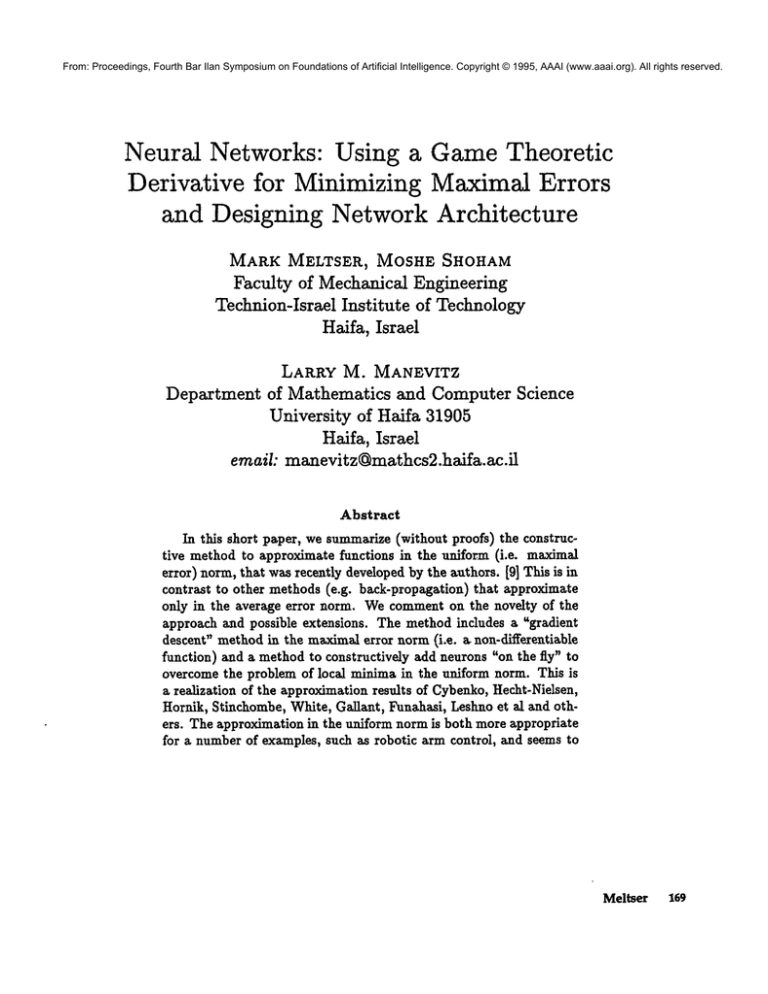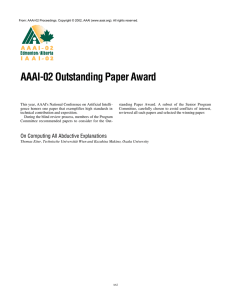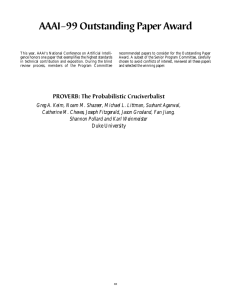
From: Proceedings, Fourth Bar Ilan Symposium on Foundations of Artificial Intelligence. Copyright © 1995, AAAI (www.aaai.org). All rights reserved.
Neural Networks: Using a GameTheoretic
Derivative for Minimizing MaximalErrors
and Designing Network Architecture
MARK MELTSER~
MOSHE
SHOHAM
Faculty of Mechanical Engineering
Technion-Israel Institute of Technology
Haifa, Israel
LARRY M. MANEVITZ
Department of Mathematics and Computer Science
University of Haifa 31905
Haifa, Israel
email: manevitz~mathcs2.haifa.ac.il
Abstract
In this short paper, we summarize (without proofs) the constructive method to approximate functions in the uniform (i.e. maximal
error) norm, that was recently developed by the authors. [9] This is in
contrast to other methods (e.g. back-propagation) that approximate
only in the average error norm. Wecommenton the novelty of the
approach and possible extensions. The method includes a ~gradient
descent" methodin the maximal error norm (i.e. a non-differentiable
function) and a method to constructively add neurons "on the fly" to
overcome the problem of local minima in the uniform norm. This is
a realization of the approximation results of Cybenko, Hecht-Nielsen,
Hornik, Stinchombe, White, Gallant, Funahasi, Leshno et al and others. The approximation in the uniform norm is both more appropriate
for a number of examples, such as robotic arm control, and seems to
Meltser
169
From: Proceedings, Fourth Bar Ilan Symposium on Foundations of Artificial Intelligence. Copyright © 1995, AAAI (www.aaai.org). All rights reserved.
converge muchfaster than analogue descent measuresin the average
norm(e.g. back-propagation). The main novelty in the constructive
proof is the use of a game-theoreticgeneralized derivative originally
due to Danskin.
Introduction
There are gaps betweenthe theoretical result ( [1], [4], [6]) that a three
level feed-forward neural network can approximate any reasonable function
and the constructive learning methods ( most notably "back-propagation")
which give a gradient descent methodto find the weights of the network based
on examples[11], [7]. Onesuch gap is that the theoretical results (existence)
guarantee arbitrary approximation in the raaziraal error norm; while the
second result (constructive) finds an answer by doing gradient descent in
the average error norm. The descent methods also have the well-discussed
problemof falling into local minima.
While the local minima problem is inherent in any descent method, the
use of the average error normwas mostly chosen because it is a differentiable
function; so the mathematical tools (e.g. chain rule) can be used to derive
the back-propagation algorithm [11], [7]. The non-differentiability of the
maximalerror norm seems to a priori rule out using analytic gradient-style
methods.
Nonetheless, the authors [9] have recently derived a constructive methodology for approximating in the maximal error norm; thereby in principle
solving this problem. To do this, we adapted a moregeneral notion of differentiation due to Danskin, developed in the context of gametheory. Thus, in
fact, we are able to do a form of gradient descent on the maximalerror since
it is differentiable in this moregeneral sense.
Wealso approached the local minima problem. This is related to the
correct choice of architecture (e.g. the numberof "hidden level" neurons).
Wedeveloped a method which allows one to "on-the-fly" add a new neuron
when the descent has reached a local minimumin such a way as to always
decrease the maximalerror. In order to derive this method, we had to further
assumethat the function being approximated is twice differentiable.
These two results can be used jointly or separately. Together, they suggest
the following methodin principle for approximating functions in the uniform
norm. First one chooses a network with a small number of hidden level
neurons. One then applies the first result, modifying the weights in order
170
BISFAI-95
From: Proceedings, Fourth Bar Ilan Symposium on Foundations of Artificial Intelligence. Copyright © 1995, AAAI (www.aaai.org). All rights reserved.
to reduce the maximalerror. Intuitively, one looks at the sample item(s)
which produced the largest error; and modifies the weights to decrease this
error. The result guarantees that this can be done without unduly increasing
the errors on the other inputs. (It seems that this method converges fairly
quickly.)
If, after convergence, the resulting maximalerror is larger than desired
(as a result of a local minimumin the uniform norm), one uses the second
result to add a neuron and then continue with the descent.
Theproofs of these results are a bit complicated([9] contains full details;
a preprint maybe obtained from http://sll.haifa.ac.il/faculty.html
and following the pointer to the author’s home page); here we simply state the
results. Wepoint out, however, that it maybe useful to look at the proofs
as well, since the use of the Danskinderivative is a techniques which maybe
useful for other measuresas well as for calculations involving fuzzy logic. (In
this summary,we include the theorem (essentially due to Danskin) listing
the crucial properties of the Danskinderivative.) Wealso have an additional
result showing how to add a neuron even when not at a local minimum.
Note that this methodis not a variant of back-propagation, but a different
descent method. In the presentation here, one deals with all of the weights
in the network (from all levels) at once and calculates a direction to decrease
the maximal error directly from the knowninputs that currently give the
largest error. (In this paper, we developed the formulas for one hidden level,
but they are directly extendible for an arbitrary numberof levels.)
Wealso point out that we are simultaneously arranging to minimize the
maximal error of each of the derivatives. However, our approach here is
somewhatdifferent than that of either [5] or [3] because we do not try to
obtain the approximation of the derivative as the derivative of the neural
network approximation; but rather as a direct approximation using additional
outputs of the neural network. In this case, a major virtue of this approach
is its simplicity; there is no need to deal with an analogue of Sobolev spaces
appropriate for the maximal error norm. On the other hand, one needs to
knowall the derivatives at the sample data points.
Experimental results using this methodare as yet spotty and we are not
yet in a position to discuss the practicality of these algorithms. However,
the preliminary results do indicate a fast convergence rate, which fits the
intuition that if one can deal with the ~outliers" one by one without allowing
other sample points to deteriorate too much, then convergence should be
Meltser 171
From: Proceedings, Fourth Bar Ilan Symposium on Foundations of Artificial Intelligence. Copyright © 1995, AAAI (www.aaai.org). All rights reserved.
quick.
The Theorems
These results are presented fully (with proofs) in [9]. Weemphasizethat all
of the results are constructive; i.e. they translate directly to algorithms.
Theorem 1 is just a restatement of Cybenko’s theorem [1]. Theorem 2
is a slight variant of Danskin’s theorem which establishes the necessary generalized directional derivatives that are needed. Theorem3 establishes how
to constructively calculate the direction of descent. Theorem4 is included
for completeness, and shows howone can always increase the rate of descent
even if one is not at a local minimumby increasing the dimension. Theorem
5 shows (using the result of Theorem3) howto increase the dimension
that the error always decreases.
Theonly result presented here whichrequires differentiability of the function being approximated(in fact twice differentiability) is Theorem5 which
depends on the lemma(below) where the hypothesis is used. In particular
the descent methodholds without this hypothesis.
As stated above, our main newtool in this paper is the use of the Danskin
derivative [2], which extends the notion of differentiability to include that
of the maximal error function. This is quite natural because the Danskin
derivative was developed in the context of game theory, and here we are
trying to minimize a maxfunction. This Operator mayhave applications in
the field of fuzzy logic where one often deals with maxand min functions, a
Wenow fix some notation:
Let M,~ be a compact connected subset of R". Suppose g is a function
from M,, to R~. If F is another function on the same domain and range, we
can consider F as an approximation to g and measure the quality of approximation by using the Hilbert normIIg- FIl~, - fM, :Ei~=l[g’(x) -- F’(x)] 2d~ to
measuresthe average error; the quality of the mazimalerror is given by the
uniform norm 119-FIll - max~M,~=l [gi(z)- Fi(z)[.
1Notethat there are moregeneral derivatives than the Danskinone, a fact which
mightbe of interest in generalizationsof ourresults; for this workthe Danskinderivative
suffices. Onthe other hand,notethat onevirtue of the Danskinderivativeis that weare
able to obtaina method
for explicitly calculatingthe directionof descent,something
that
is lackingin moregeneralmethodssuchas distributions.
172
BISFAI-95
From: Proceedings, Fourth Bar Ilan Symposium on Foundations of Artificial Intelligence. Copyright © 1995, AAAI (www.aaai.org). All rights reserved.
0
0
~
©
©
D/leU I’OIIS
(inpul)
0
0
0
0
©
~U
©
©
©
©
o~,..roo,
(output)
! neurons
(hidden)
Figure 1: A 3-level Neural Network
Nowassume that g is continuous and that F is generated by a neural
network. To be specific, let us suppose that F is given by the smallest
architecture feed-forward neural network that has the universal properties,
[4], i.e. a three level neural network. (Let n the numberof neurons on the
first layer and rn neu tons on the third layer and l neurons on the hidden
layer.) Assumethat each neuron in the hidden layer responds by a simple
sigmoidal S(t) 1 Th
1.i.e-~ e¯ th ird la yer ne urons combine their in put li nearly.
Our constructive results are presented in this paper for such a network, but
their generalization to networks with more levels or different combination
functions is straightforward.
Wecan denote the weights by the matrices WO)(a l x n matrix) for
(2) (an m × l matrix ) for
weights between the firs t and second layer and W
the weights between the second and the third layer and by an l- length
vector ]3 the thresholds of the second layer. See figure 1.
Thus our function F - (Fi, .... F,n) is given by the formula
Meltser
173
From: Proceedings, Fourth Bar Ilan Symposium on Foundations of Artificial Intelligence. Copyright © 1995, AAAI (www.aaai.org). All rights reserved.
FsCx, y) = ~W(~) f(ut(x,y)),
where ut(x,y)
t=l
~’~W~)xj + 8,
j=l
Theorem1 [I] For any continuous vector-function g : M,~ ---r t~ and for
any small ~ > 0 there exists a function F generated by the NN-methodsuch
that IIg-Fill < ,.
The goal is to effectivize Cybenko’s theorem, i.e. to show howto construct such approximation in the uniform norm. Werepeat that previous
constructive methods have worked in the Hilbert norm.
Denote by the vector y all of these free parameters; thus the parameters
y are chosenfrom the space R(’~+’+l}t, i.e. y = (yl,..., y(,~+,~+l)t). Note
the dimensionof y is a function of l; i.e. weallow for the possibility that the
number of hidden neurons changes.
Denote by ¢(x,y) and ¢(y) the functions
Thus, the problemis to find y, minimizing¢. (Since it is easy to see that
there are positive constants C1, (72 such that CIlIg-FI]~ < ¢(y) < C21[g-F]]~
it follows that ¢ as a normis equivalent to the uniform norm.)
Theorem1 shows that there exist choices of the parameter y (including
the choice of l) so that ¢(y) is arbitrarily small. Onehas to to showhow
constructively find the y.
Let 7 be a direction (i.e. a unit vector) in the space (~+’~+1)1.
Definition: The Danskin operatorin direction ~, of ¢(y), (D~¢)(y),
(DT¢)(y) = lira l[¢(y + aq,) _
~---~0+Ot
The following result is an immediate variant of that originally due to
Danskin[2].
174
BISFAI-95
From: Proceedings, Fourth Bar Ilan Symposium on Foundations of Artificial Intelligence. Copyright © 1995, AAAI (www.aaai.org). All rights reserved.
Theorem 2 Properties of the Danskin operator :
(i) If (D~¢)(y) is negative at yl, then ¢(y) decreases in direction
(ii} For each point y and each direction 7 (D~¢)(y) ezists.
(iii) (D.y~)(y) has the
= -¢x(y)
max< %(z,y),7>.
[ Here X(y) = {z E Mn: ¢(z,y) = q~(y)} the set of mazi mal points of
the function 0(z,y), ~u(z,y) = (~a(z,y),...,~t.~+,+l),(z,y))
R( ’~+’+l)t
is a vector of partial derivatives ¢y~(z, y) a~rz
= ~ , y), and < %(z,y),7 >=
EC,~
i=t+.+l )z ~(z,y)Ti is a scalar product in the space R("~+"+l)t.]
Corollary 1 The Danskin operator (D.y¢)(y) is a continuous function on
the variables 7 and y.
The following theorem provides the constructive rule for our version replacing gradient descent.
Theorem3 Let yl be an arbitrarTI point in R(~+’+l)z with ff(yx) > and
let
or1 =¢E~,<o
- q~+Eq,_>.o r~ and CrZhoYd~,,<ory + Eq,>_.oq~ ¯
Then ezactly one of the following
(i) yx is a local minimumpoint of ¢(~I)
(ii) the function ~(y) decreases in a direction 7° ( we caUit an antigradient of 4~(~)in the point y~ ), whichis defined by coordinates
{
"tO=
if <_o
if >_o
0 ~x ifqi<O<ri
Theorem 4 Suppose yl isn’t a local minimumpoint of ¢~(~t) in the space
R¢’’+’+1)t, and let 7° be an anti#radient from the point ~1 . There ezists
a direction 71 E R(’~+’~+l)(t+x) such that (D~lff)(~/x) (D.roq~)(y x) . (This
direction can be obtained constructively1.}
Meltser
175
From: Proceedings, Fourth Bar Ilan Symposium on Foundations of Artificial Intelligence. Copyright © 1995, AAAI (www.aaai.org). All rights reserved.
In order to consider the correct passage from a local minimum
to a better
approximationwith an increase in size of the hidden layer, it is necessary to
assumethat g is twice differentiable. Onethen approximate g and its partial
derivatives simultaneously. (This is necessary for the proof of the lemmathat
follows.)
Since the previous theorems of course hold in this case, this meansthat
one has a constructive method for the simultaneous approximation in the
uniform norm of both the function and its partial derivatives; under the
assumptionthat the function is twice differentiable. (For a different kind of
approximation to the function and its partial derivative see the papers [5]
and [3].)
Lemma1 If y1 is a local minimumpoint in the space R(’~+~+l}t and ¢(yX)
O, then the set of maximalpoints X(y1) does not include an open subset.
Theorem5 Let a vector yl be a local minimumpoint of the function ¢(y) in
the space R(rn+’~+l)/ and let ¢(ya) > 0 Then th ere exists a parameter # > O,
vectors /~ = (Bx,...,Bt) e Rt with Bi > 0 , ~ = (~I,...,A,~)
e m with
I[~ll = 1, and fi = (P1,...,P~+I) e ’~+1 such t hat avector9 ¯ R(’~+"+1)(t+1)
with coordinates
Pj
/fi = (s -- 1)l +
if i= s(l + 1)
ifi=m(l+ 1) + (n-- 1)t
ifi=(m+n--1)(l
+ l)+j
P,,+I
ifi=(m+n+l)(l+l)
yl_s+l -- Bt)~s
if i = (m + + 1) +t
satisfies the inequality ¢(~) < ¢(yl). (These parameters are given constructively in the proof.)
In other words the newweights are given by
i~¢7{2) ~ {2)
¯ ,t Bt,~s
¯ ,t =[ ~tA~
176
BISFAI-95
(s =1,...
,m;t=l
(s=l,...,m;t=l+l)
...,l)
From: Proceedings, Fourth Bar Ilan Symposium on Foundations of Artificial Intelligence. Copyright © 1995, AAAI (www.aaai.org). All rights reserved.
About the
Algorithms
The algorithms are described in the proofs given in [9]. (Space constraints
preclude a complete description here.) There is a further paper planned
[10] describing an implementation and experiments. The descriptions of the
algorithms is complicated somewhatbecause of the necessity at each stage to
worry about the possibility of multiple data giving the same maximalerror.
However,if we suppose that the maximalerror always occurs at a singleton,
then the descent methodis very straight-forward.
To perform gradient descent (Theorem3), one calculates the usual partial
derivatives for each of the weight parameters of the error function cI, at the
maximal input error point. Then one uses this gradient information to determine a direction to move. The existence of multiple maximalerror points
requires looking at the partial derivatives of each of these points. Thus this
method is relatively simple to implement.
To add a neuron (Theorem 5) when one is in a (L~) minimumis somewhat more complicated. One first has to identify a "critical neuron" in the
hidden level. Roughly speaking, one finds a neuron which behaves the most
like another neuron in the hidden level for points in the domain. The new
neuron is chosen then to mimicthis critical neuron (i.e. /~ is the same as
the weights to the critical neuron). All input weights and output weights
from old neurons are kept the same, and only the output weight from the
"critical neuron " is reduced. Unfortunately, the above is not sufficient to
guarantee that an outgoing weight from the new neuron can be chosen so
that the maximalerror always decreases. (In the notation of Theorem5, this
is reflected in the choice of #.) However,a secondary use of gradient descent
using the Danskin derivative, modifying the choice of/~ and/~, guarantees
the possibility of choosing such a # giving such a decrease.
References
[1] G. Cybenko. Approximationby superpositions of a sigmoidal function,
Mathematics of Control Signals and Systems P, pp 308 - 314, 1989.
[2] J. Danskin. The Theory of Maz- Min, Springer - Verlag, New- York,
1967.
Meltser 177




